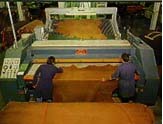Tanning Process
- by Super User
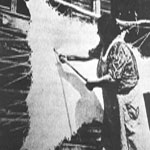
Leather Tanning - The crucial process that gives your leather beauty and longevity.
LEATHER TANNING PROCESS
Tanning is the process converts the protein of the raw hide or skin into a stable material which will not putrefy and is suitable for a wide variety of end applications
Raw material
Raw hides arrive at the tannery preserved in salt.
They are stiff and need to be soaked to make them pliable so the tanning process can begin.
This is called "WET BLUE PROCESS"
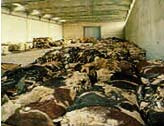
Fleshing
The wet hides are run through twin rollers.
One equipped with knives, the other covered with rubber.
This removes unwanted fat and flesh.
Liming
Hides are put in drums and rinsed in fresh water for 24 hours.
Hides are now returned to original condition ready for tanning.
Lime & acids are added to remove hair.

Splitting
Hides are now split.
The splitter has 2 cylinders between which a sharp running blade slices the hide in half.
The top layer is called "TOP GRAIN" ,the bottom layer is called "SPLIT"
Tanning
The chemical process by which raw hides are preserved and turned into leather..
Hides are tanned with chromium salts.
Chrome Tanning
Hides are now light blue and ready for dying.
Sammiering
Hides are run through a roller which removes unwanted water.
Shaving & Trimming
Hides are trimmed of unwanted material and the backs shaved to a uniform thickness.
Dyeing
The tanned hides are placed in wooden drums.
Water, fats, resins and dyes are added to achieve the required colour.
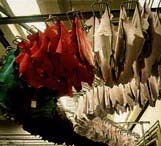
Drying
Hides are dried at a controlled temperature and humidity.
Staking
Hides are put through a machine with a pin wheel to soften the leather.
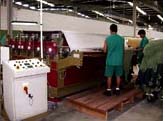
Dry Milling
Hides are placed in a rotating drum for milling to achieve required softness.
Buffing
Hides are run through a buffing machine.
An abrasive roller removes a small part of the top layer.
Heavy imperfections are removed in this process.
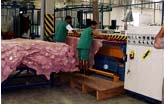
Finishing
Hides are now given a uniform pigment coat.
Hides are given a polyurethane coating for protection.

Embossing
The hides are finally run through a press.
This process imprints a texture on the hide further masking imperfections.
